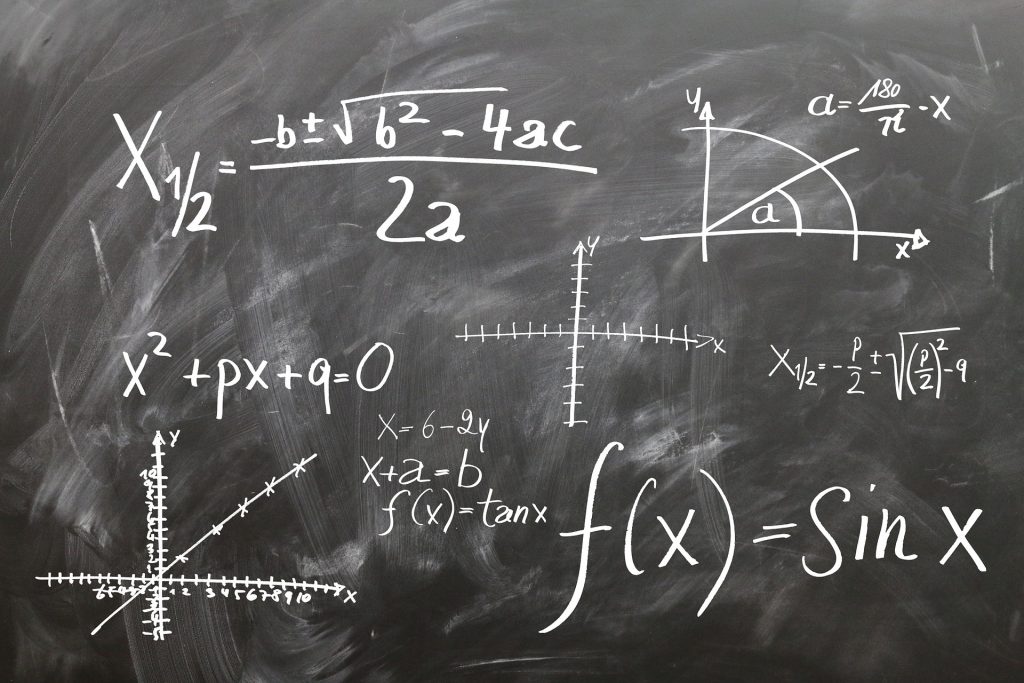Rationalising the denominator
This is something which comes up in the topic of surds, although the word denominator is a term which comes up in fractions and so this Maths skill combines both topics as well as a few skills from algebra thrown in. It is a fairly high level skill in Mathematics and also, at the highest level, combines the algebra concept known as the difference of two squares. In this post I shall attempt to untangle these terms and link them together.
Rational and irrational numbers
Some numbers are easy to write down. The answer to 3 + 5 is 8. Some would take forever to write down. The answer to 1 ÷ 3 is 0.333333….. and so on. You can get around this by saying “nought point three recurring” which is written by putting a little dot above a 3 as shown below:
![]()
I could also write this as ⅓ if I wanted. But, some numbers are impossible write down in a way that would tell the reader what digit comes next. In the example above we know we just keep writing 3s. An irrational number also goes on forever, but we have no idea what the next digit is. If we take a circle and measure its circumference and then divide it by its diameter we will get the irrational number pi, written as π.
When you square root many numbers you also get irrational numbers. The square root of 9 is 3, because when I multiply 3 by itself I get 9. What number would I need to multiply by itself to get 2? Or 3, 5, 6, 7 or 8? It is impossible to say. When you square root any of these numbers on your calculator you get a whole mess of digits. In other words, they are irrational numbers. Irrational numbers are usually written in different forms for this reason. The square root of 2 is simply left as: √2. But… I take √2 and I multiply it by √2 I get 2. I have now rationalised it. It started off irrational and now the answer is rational.
√2 x √2 = 2
WHAT ARE QUADRATIC EQUATIONS AND HOW DO I SOLVE THEM?
Let’s start rationalising some denominators!
The denominator of a fraction is the number at the bottom. The top number is called the numerator.

So in the fraction ⅓, the numerator is 1 and the denominator is 3. We are essentially dividing 1 by 3. Let’s look at a fraction when we have a square root as the denominator:

We may be asked to rationalise the denominator here. If we were to multiply the denominator by root 3, we would get 6: 2√3 x √3 = 2 x 3 = 6. But, we would be changing the value of the expression if we did. When we are asked to rationalise the denominator, what is often unsaid is that the value of the expression must not change, it is simply rewritten in a different way.
One thing we can do to any number without changing it is multiply it by 1. Doesn’t sound much use really does it? Well, any number divided by itself is also 1, so I could do the following without changing the value of the expression:

When multiplying fractions you simply multiply the top by the top and the bottom by the bottom. You then simplify if necessary:
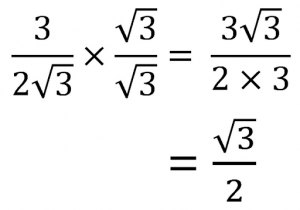
… and we have rationalised the denominator! Cool. It is still an irrational number of course, so it still has an irrational component, but it is now the numerator rather than the denominator.
WHY SHOULD YOU BOOK A MATHS TUTOR?
The difference of two squares
Let’s imagine we have two squares. One has lengths a and the second has lengths b. The first area would be a² and the second area would be b². The difference of the two areas would be a² – b². We can call this the difference of two squares.
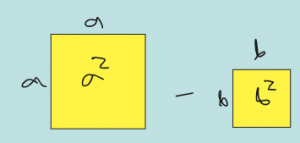
Now let us imagine we factorised another expression:
(a+b)(a-b)
= a² + ab – ab – b²
… we notice the middle two terms cancel out.
= a² – b²
… and we have the original expression which I referred to as the difference of two squares! In other words:
(a+b)(a-b) = a² – b²
Rationalising more difficult surds
Imagine we were asked to rationalise this expression:
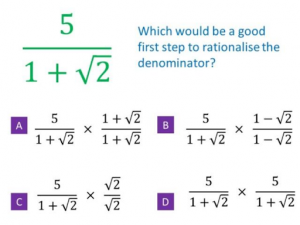
As discussed earlier we can multiply it by anything which is divided by itself as that would be the same as multiplying it by 1. Which one of the options below do you think makes the most sense? Cover the text below to test yourself!

Hopefully you said option… B! We are allowed to do all examples apart from option D, but only option B applies the difference of two squares which ends up rationalising the denominator because:
(1 + √2)(1 – √2) = 1 – 2 = -1
… and so
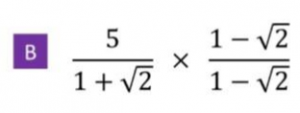
5(1 – √2)
-1
= 5√2 – 5
So, we have rationalised this denominator as well! That’s pretty much it, but if you think you would like more practice and teaching on this topic check out this video by Maths genie and this one by Cognito. You might also like to practice using this worksheet by Corbett Maths.
Good luck!
A bit about the author, Paul H:
 Paul is a qualified and experienced Physics, Maths, and Science teacher, now working as a full-time tutor, providing online tuition using a variety of hi-tech resources to provide engaging and interesting lessons. He covers Physics, Chemistry, Biology, and Science from Prep and Key Stage 3 through to GCSE and IGCSE. He also teaches Physics, Maths, and Chemistry to A-Level across all the major Exam Boards.
Paul is a qualified and experienced Physics, Maths, and Science teacher, now working as a full-time tutor, providing online tuition using a variety of hi-tech resources to provide engaging and interesting lessons. He covers Physics, Chemistry, Biology, and Science from Prep and Key Stage 3 through to GCSE and IGCSE. He also teaches Physics, Maths, and Chemistry to A-Level across all the major Exam Boards.

